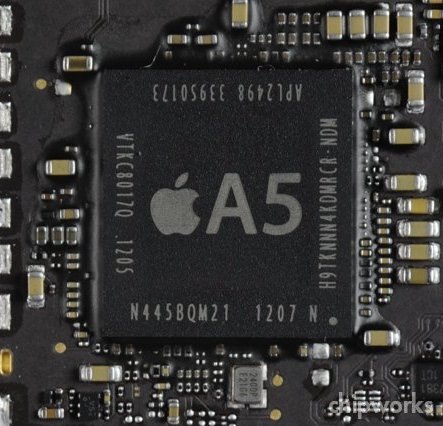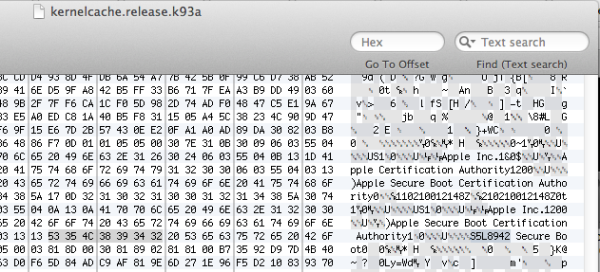Apple's iPad 2,4 also uses 32nm A5 S5L8942 SoC
by Brian Klug on April 11, 2012 2:27 PM ESTThrough Chipworks, we recently learned that Apple's revised A5 SoC (S5L8942) is built on a 32nm Samsung HKMG process. While its presence in the Apple TV (3rd generation) which we've reviewed and inspected is an absolute certainty, up until recently it hasn't been as common knowledge that the iPad 2,4 ($399 cost reduced Wi-Fi model) also contains the same S5L8942 SoC but with both A9 cores enabled, as opposed to the single core A9 configuration of the Apple TV 3.
To quell any possible naysayers, I grabbed the "iPad2,4_5.1_9B176_Restore" image a while ago, opened it up, and inspected the kernelcache for references to S5L8942, which there are. Note that the iPad2,4 is k93aap, there are numerous other references to S5L8942 elsewhere, including the buildmanifest plist, eg "Firmware/all_flash/all_flash.k93aap.production/glyphcharging.s5l8942x.img3." There's no question about S5L8942 (A5R2) being inside iPad2,4.
The end result is that if you're an iPad2,4 owner, you've got Samsung 32nm HKMG silicon inside. There's no doubt about iPad2,4 being out and in the wild either, as a number of geekbench 2 runs have popped up since release on their online result browser, which I've been watching like a hawk. As an aside, performance between the S5L8942 (A5R2) and S5L8940 (A5) is virtually unchanged between the iPad2,4 and iPad2,1 if you compare runs on the result browser.
The interesting other question is whether iPad2,4 owners have improved battery life compared to those with iPad2,1 (WiFi), though admittedly that's not going to be a common upgrade path for existing iPad 2 owners to check out. I no longer own an iPad 2 but am going to set out to measure and compare to see just how much of a difference there is, which in turn might say something interesting about Samsung's 32nm HKMG process.
Overall, Apple porting the existing A5 design to Samsung's 32nm HKMG process makes a lot of sense to both test the waters and figure out any design issues, as well as not jeopardize production for the high end. At this point seeing another future Apple product using Samsung 32nm HKMG would not be very surprising.

32nm A5 in iPad 2,4 (Source: Chipworks)
Update: Chipworks has also updated and confirmed with a teardown of an iPad2,4 that the expected 32nm A5 S5L8942 is indeed inside.











28 Comments
View All Comments
saurabhr8here - Wednesday, April 11, 2012 - link
A very interesting revelation. So there is a very high probability that we would be seeing an Apple A5X using Samsung's 32nm HKMG process very soon. About 40% reduction in chip area and hopefully, better battery life. It is possible that the 32nm HKMG process was not mature enough for the A5X or Apple decided to go for a low risk A5 single core first.The Chipworks article also mentions that the A5 single-core processor is actually dual-core with one core disabled. Its possible that Samsung's 32nm HKMG process is not mature enough with low yields, resulting in a large number of chips with a single working core.
tipoo - Wednesday, April 11, 2012 - link
I wonder, does this mean a silent change to 32nm for the new iPad as well? The current design seems pretty power inefficient. I'd like to see if the 32nm jump changed the battery life on those iPad 2s.tipoo - Wednesday, April 11, 2012 - link
Another thing, there was talk of an "enhanced" A5X for the next iPhone and iPod Touch, maybe this is it, 32nm would reduce the increased power draw from this chip.pareklund - Wednesday, April 11, 2012 - link
Yes, I didn't believe the rumors before but given a 32nm HKMG process, it could actually be true, given decreased clock speeds in a similar fashion w/ the iPhone 4S vs. iPad 2.ltcommanderdata - Wednesday, April 11, 2012 - link
For the iPod Touch, I think this 32nm A5 is the most likely candidate. I'm still hoping for a true 32nm A6 for the next iPhone, but Apple would no doubt also be working on a 32nm A5X as a backup.ajp_anton - Wednesday, April 11, 2012 - link
I doubt the A5X will go into an iPhone. Even with its Retina, it's not in desperate need of rebalancing its CPU/GPU as the new iPad was.I think that when the iPhone gets a GPU bump, it will be together with a CPU bump as well.
tipoo - Wednesday, April 11, 2012 - link
Maybe this will be the first time the CPU in the iPhone is better than the iPad. The GPU is adequate for the iPhones resolution, but more CPU performance would be noticeable.deepey - Wednesday, April 11, 2012 - link
Is there some way to tell at the store or even if ordering online from Apple's site? I'm thinking this will be the way to go - lighter, thinner, and just as fast as the new iPad but with even longer battery life than the original iPad 2 and none of the weird screen problems of the new model. Sounds ideal.Brian Klug - Wednesday, April 11, 2012 - link
I need to investigate more, and am trying to find one for myself honestly, but I believe there's still some chance involved.-Brian
ltcommanderdata - Wednesday, April 11, 2012 - link
Seeing Brazil seems to be becoming the new testbed for Apple with new Brazil specific Apple.com website features being reported today, maybe the iPad2,4 actually refers to iPad production at Foxconn's new Brazil plant, and the iPad2,4 is primarily available to the Brazil domestic market until production ramps? Chinese made iPad2,1 production could be continuing in parallel keeping the existing 45nm A5 and is what is currently feeding most of the world.